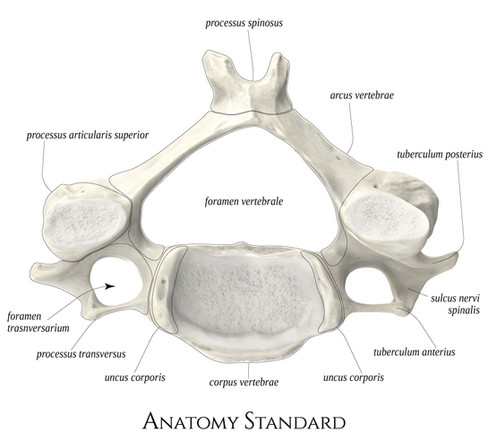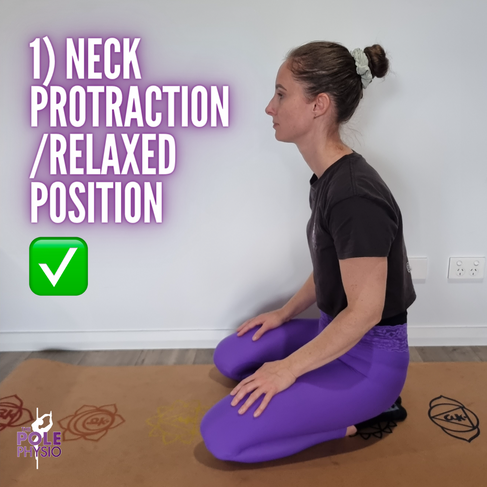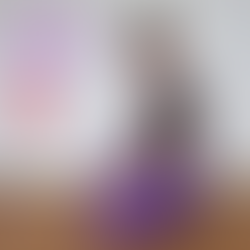Head Rolls and Hair Flicks - A Pain in the Neck!
- Danielle Davey
- Jul 1, 2023
- 8 min read
How satisfying is a big hair flick on the beat in a performance? How about a smooth head roll to create a seamless change of direction in choreography class? 😍
We all love the aesthetic and the feeling of great head motions or “hairography” as it’s sometimes called. Sadly, these movements don’t always feel so good! If you cringe every time your instructor yells “aaaand HEADROLL”, then this blog is for you friend.

Common Neck Symptoms and Causes
Have you felt any of these?
Cramping or pain in the neck
Waking feeling stiff and sore the day after dancing
Headaches
Dizziness when doing multiple head rolls, settling quickly
Feeling clunky
Like all other injuries, neck pain, stiffness, and feeling clunky usually comes down to a load vs capacity issue. This means the body doesn’t have the strength, coordination, or range of motion (ROM) to achieve what we are asking (ie the demands of the skill). Ideally, we want the body’s capability to be greater than what the skill requires so we can perform the movement with ease! And as a nice little side bonus, the head roll will probably look better too!
The most common anatomical sources of pain and stiffness in the neck are joint capsule and ligament sprains, muscle strains, and plain old muscle tension. Headaches can also come from these sources. Headaches originating from the neck are called cervicogenic headaches, and mostly come from the upper neck (occiput/base of skull to C2). We won’t be discussing headaches in depth during this blog.
And dizziness is a whole topic on its own. Some has already been covered in our 'spin pole sickness blog' found here. The muscular work in this blog may help with some types of dizziness, but keep in mind that it won’t be relevant for all.
Possible causes for concern
Let’s get the important medical things out of the way first. Certain symptoms, known as ‘red flags’ in the healthcare world, may require further investigation. If you experience any of the following, do NOT try the activities in this blog and seek immediate medical advice.
The 5 D’s and 3 N’s (plus one):
Diplopia - double vision
Dizziness - lasting more than a few seconds (especially if it continues the next day)
Drop attacks - sudden fall with no cause, with or without losing consciousness
Dysarthria - difficulty articulating speech where there is normally no problem
Dysphagia - difficulty swallowing
Ataxia - new clumsiness such as dropping things or struggling with balance or coordinating walking
Nausea
Numbness
Nystagmus - involuntary, rapid, repetitive eye movements. Often a flicking to the side motion
These symptoms can be a concern of something larger at play and always require medical review.
Anatomy
It’s our favourite time- anatomy time! Today we are keeping it very functional. The neck, or cervical spine, is made up of 7 vertebrae. It’s main job is to support the head, and provide a pathway for the spinal cord and blood vessels to the rest of the body. Sounds important right?? It’s not an easy task- an adult’s head weighs around 10% of our body weight! 😱
Our neck also plays a key role in supporting our balance and vision, moving an incredible number of times per hour (Cobain et al., 2009)
Most of the vertebra in the neck are fairly typical, attaching one to the next by a disc and 2 facet joints. The upper cervical spine (occiput/base of skull, C1 and C2) is quite unique.
Left picture: standard cervical vertebrae (C3-6)
Right picture: C1 & C2 vertebrae
The upper cervical spine has the most amount of responsibility for controlling and orienting the head. Approximately 50% of cervical rotation ROM comes from our upper cervical spine (Reference #2). There are 2 important things to remember with the upper neck due to this:
More ROM means a need for more strength, awareness, and control.
This area and the associated muscles can be a source of headaches, which makes point 1 even more important when it comes to complex and fast movements like hair flicks.
So, what can I do about my neck pain and head choreo struggles?
In essence, we need to increase the capacity of the tissues in the neck. Whilst there is no formal research specific to pole or even dance that measure the demands of how much strength, ROM, etc is needed for head rolls <need to check this>, we do have data for “normal humans” and clinical reasoning from well experienced practitioners.
Neck range of motion
Rest of the body helping, especially thoracic area, shoulders, core, and breath pattern
Control and strength of the neck
Coordination of complex movement patterns
Load management (deloading, progressive rehab, staged reloading)
1. Neck range of motion (ROM)
Basic ROM of the neck can be measured in degrees. This can be done by taking photos and measuring angles as shown below. These images are labelled with what is considered “normal” range of motion for the non-pole population. If you have symptoms and:
Reduced ROM- this may be one piece of the puzzle for you. There are loads of techniques you can use at home to help, best prescribed by someone who has detailed knowledge to ensure they are safe and target areas YOU need.
Extra ROM- it’s possible you need to work on your strength and control, further down the page. Note you may still have the sensation of tightness or stiffness, even if you have bonus ROM! This often means the muscles are weak, not truly tight.
Next, it’s good to test different ways of combining these individual ROM directions, as this is more functional for head movements at pole. Try out this controlled articular rotation (CAR) shown.
2. We aren’t just a head and neck!
Let’s not forget that “every action is a whole-body action!” Can you tell we love this saying?
It sounds obvious, but the neck must attach to something! It has bony connections to the thoracic spine, and muscular connections through the thorax, shoulders, and even into the lower back. Some additional necessities for good neck function include:
Thoracic and shoulder movement and control
Core control
A good breathing pattern
When the thoracic region and shoulders assist in hair flicks and head rolls, less movement is required from the neck. Check out these still shots of a hair flick, comparing how much ROM the neck has to contribute in each case. The neck has far less work to do when the thorax and shoulders help.
Using core to control movement of the body, especially the rib cage, gives a strong base of support for our head movements. Remember many of our neck muscles attach to the trunk. If the body is relaxed and floppy, the neck muscles work double time!
Have you ever thought about how your breathing relates to your neck? The main muscle to help us inhale is our diaphragm. Dysfunctional breathing patterns are common, and can involve using neck and shoulder muscles to help breathe in. Again, this is more work than the neck really needs. Poor breathing patterns can be related to stress, chronic abdominal pain, muscle tightness, or even poor core control.
Did you know expert pole and dance physios can assess and help you work on all of these things?
Self-test time!
3. Strength and Control of the Neck
This is a big one! There are loads of variations and progressions of neck control and strengthening.
First, we need to be aware of the position of the head on the neck, in other words what our upper cervical spine is doing. Many people have seen or been prescribed chin tuck exercises, but they are rarely done well and should only be the very start of neck rehab, as they are very low load. Let’s see how to do them well:
The neutral chin tuck position is a nice happy “home base” position for the head to move from. The flexors and extensors are both helping to support the head on the neck here.
Isometric strength
Isometric means strengthening while stationary. This can be a good place to start if you’ve not done any neck strength before, as it gives you a chance to work on awareness of where the head and neck are in space before adding complex movements.
Option 1: banded.
Find your neutral neck position by using a slight chin tuck. Place band around middle of head and add a little tension by pulling with hands. Maintain the neck position, aiming for sustained holds, rather than reps. The band can also be tied around the pole to achieve this without having to use hands.

Neck flexors and extensors

Lateral control
Option 2: vs gravity.
We can leverage gravity to use our head as a weight. Try face down, face up, and side lying on each side to work different neck muscles. Each option is labelled with a rough guide of what is considered a “normal” amount of time for a “normal” human to hold in a good position for. If you start shaking, are holding your breath, or have lost your neutral spinal position, that is time to stop.
Strength through range
The next step is controlling the head and neck as we move, starting with basic movements. These can be done in sets like any other strengthening exercise, stopping when you feel fatigued. We recommend starting small with only 1 set of 5-6 at most, as you can end up with quite sore muscles next day if you aren’t used to strengthening your neck!
4. Make it functional
You’ve worked on all the moving pieces, so now it’s time to start practicing the action you’ve been dreaming of! Mastering the perfect hair flick or head roll. We have some recommendations to get back into it:
Start small and slow. Practice body awareness and control of the head and neck in a mini version of the head movement you’re working on. As you become more confident, progressively make the action bigger and faster over multiple sessions.
Video yourself in slow-mo. Use technology to help self-critique!
Reduce the load while you work on the strength.
5. Reducing the load
Load modification exercises might include modifying speed, repetition, amplitude of movement, weight, etc. Try changing one or more of these so the capacity of the neck and body exceeds the load of the exercise, as we mentioned earlier:
Don’t go “full out” every time. Consider “marking” your head movements in choreo by making them smaller, slower or replacing more complex motions (fig 8 roll) with easier ones (regular roll).
Hair is heavy! We can’t change the weight of our head, but putting your hair in a bun or pinning it can help.
When working on a performance with a head or hair piece, consider using a smaller practice piece or using the piece only every 2nd or 3rd run.
Top tips for neck pain
Our team LOVES a good head roll or hair flick, and we hope this helps you to enjoy them more too.
If you’re struggling with neck pain, please know that it’s common but not normal and you don’t need to put up with it! And as much as we all love a good massage for temporary pain relief, it won’t fix the problem long term.
Our online team is here to save the day as always. Online telehealth appointments can be booked via our ‘Book Online’ page that can be found here. Assessment and tailored rehabilitation are provided in accordance with best practice and evidence-based treatment to help you unleash your 'pole-tential'.
In the meantime, our top tips are to match your training load to your capacity in the short term, if you continually feel stiff then weakness may be the root of the problem, and always remember to control the weight of your head by moving with purpose.
So, if you’re wanting to learn more on how to progress through pole whilst reducing your risk of hip injury, or if you’re wanting to address an already present hip injury, then touch base with our online physios. They understand pole, they understand hips, they understand pain, and they know how to get you the results you desire. Chat with them to create your individual management plan.
Until next time, train safe & happy poling.
The Pole Physio
x
References:
Cobain, DG, et al. 2009Task Specific Frequencies of Neck Motion Measured in Healthy Young Adults over a 5 Day Period, Spine (Phila PA 1976). https://www.ncbi.nlm.nih.gov/pmc/articles/PMC2867363/
https://www.anatomystandard.com/biomechanics/spine/rom-of-vertebrae.html






























savvy mining…
crypto mining…
cesur mining…
six mining…
stainless steel…
万事达U卡办理 万事达U卡办理
VISA银联U卡办理 VISA银联U卡办理
U卡办理 U卡办理
Stainless Steel…
蜘蛛池搭建 蜘蛛池搭建
savvy mining…
crypto mining…
cesur mining…
six mining…
stainless steel…
万事达U卡办理 万事达U卡办理
VISA银联U卡办理 VISA银联U卡办理
U卡办理 U卡办理
Stainless Steel…
蜘蛛池搭建 蜘蛛池搭建
savvy mining…
crypto mining…
cesur mining…
six mining…
stainless steel…
万事达U卡办理 万事达U卡办理
VISA银联U卡办理 VISA银联U卡办理
U卡办理 U卡办理
Stainless Steel…
蜘蛛池搭建 蜘蛛池搭建
savvy mining…
crypto mining…
cesur mining…
six mining…
stainless steel…
万事达U卡办理 万事达U卡办理
VISA银联U卡办理 VISA银联U卡办理
U卡办理 U卡办理
Stainless Steel…
蜘蛛池搭建 蜘蛛池搭建
savvy mining…
crypto mining…
cesur mining…
six mining…
stainless steel…
万事达U卡办理 万事达U卡办理
VISA银联U卡办理 VISA银联U卡办理
U卡办理 U卡办理
Stainless Steel…
蜘蛛池搭建 蜘蛛池搭建